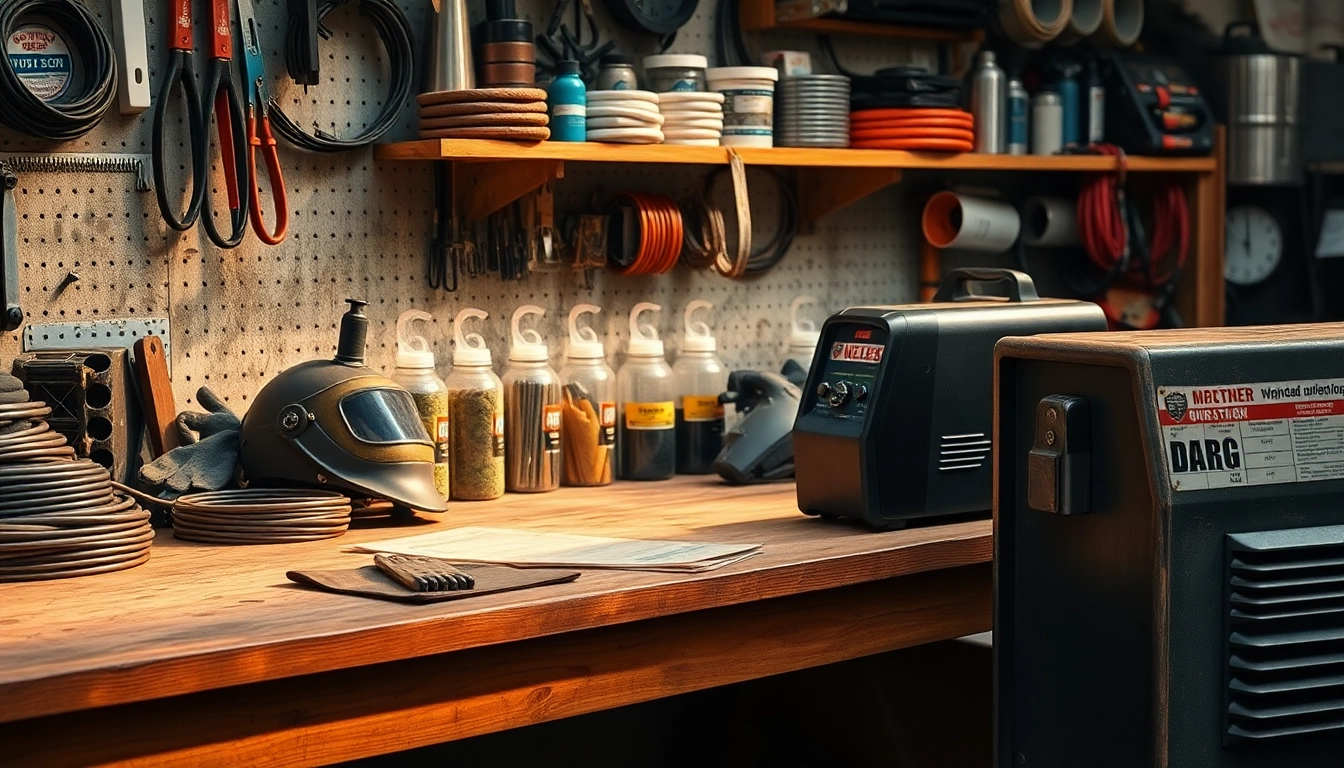Top Welding Supplies You Need for Your Next Project
Understanding Welding Supplies
Welding is a crucial process in various industries, encompassing everything from automotive repairs to structural fabrication. To achieve quality results in any welding project, having the right welding supplies is essential. This article delves into the different types of welding processes, the necessary supplies, and crucial considerations in selecting the right equipment, ensuring that welders of all skill levels are well-equipped to tackle their projects.
Types of Welding Processes
Welding is not a one-size-fits-all application; different processes are suited for various projects and materials. Below are the primary types of welding processes:
- MIG Welding (Metal Inert Gas): Often considered the easiest welding technique, MIG welding uses a continuous wire feed as an electrode and an inert gas to protect the weld pool from contamination. This makes it ideal for beginner welders and projects involving thinner materials.
- TIG Welding (Tungsten Inert Gas): Known for its precision, TIG welding uses a non-consumable tungsten electrode and a separate filler material. It’s commonly used for welding thin sections and offers a high degree of control, though it requires more skill to master.
- Stick Welding (Shielded Metal Arc Welding): This process uses a coated electrode that melts to form the weld. Stick welding is portable and effective for outdoor use, making it popular for construction and repair tasks.
- Flux-Cored Arc Welding (FCAW): Similar to MIG welding, but uses a tubular wire filled with flux. FCAW can be used without shielding gas, making it suitable for outdoor work where wind can dissipate protective gas.
- Submerged Arc Welding (SAW): This automated process is ideal for thick materials and provides a strong, clean weld without the need for shielding gas, as the weld area is submerged in a layer of flux.
Common Welding Supplies
Regardless of the welding process used, several essential supplies are needed:
- Welders: Depending on the method chosen, welders can vary greatly in size and complexity, from portable MIG units to large industrial TIG machines.
- Electrodes and Filler Metals: These materials are necessary for creating strong joints. Different processes require specific types, such as solid wire for MIG and filler rods for TIG.
- Protective Equipment: Safety must always come first. This includes helmets, gloves, and protective clothing to shield against sparks and UV radiation.
- Cleaning Tools: Maintaining clean surfaces is crucial for quality welds. Supplies like wire brushes and grinders are integral to the prep process.
- Gas Cylinders: For processes like MIG and TIG, proper shielding gases (argon, carbon dioxide) are vital to protecting the weld pool from contamination.
Choosing the Right Equipment
When selecting welding supplies, consider the following factors:
- Material Type: The type of metal you’ll be working with dictates the process and equipment needed. Different materials (steel, aluminum, stainless steel) may require unique approaches.
- Project Size: Large projects may benefit from industrial-grade equipment, while small home projects can be addressed with smaller, more affordable tools.
- Skill Level: Beginners should start with user-friendly options, while experienced welders can opt for more advanced equipment that offers greater flexibility and control.
- Budget: Quality welding equipment can be a significant investment. Determine a budget that balances quality with affordability to ensure long-term productivity without compromising safety.
Essential Welding Gear
Without the right gear, even the most skilled welder may struggle to produce quality results safely. Essential gear includes safety equipment and other accessories that maintain both comfort and productivity throughout the welding process.
Safety Gear for Welders
Safety gear is non-negotiable in the welding profession. Here are some of the critical safety supplies:
- Welding Helmet: A high-quality helmet protects against harmful UV rays and bright lights, while auto-darkening helmets offer convenience and enhanced visibility.
- Welding Gloves: Good-quality gloves protect hands from heat, sparks, and sharp edges. Look for gloves that balance dexterity and protection.
- Respirators: Protect against toxic fumes and particulates produced during welding. The choice between a simple mask and a more industrial respirator depends on the materials being welded.
- Safety Footwear: Steel-toed boots should be considered essential to prevent injuries from falling objects or hot materials.
- Protective Clothing: Flame-resistant jackets and aprons safeguard skin from sparks and heat, ensuring a safer working environment.
Welding Helmets Explained
Welding helmets come in various options with different features designed to enhance safety and performance:
- Fixed Shade Helmets: These helmets have a fixed tint level, making them suitable for certain applications but less versatile.
- Auto-Darkening Helmets: These helmets use sensors to adjust the lens shade according to the brightness of the arc, allowing for clearer visibility before and after the weld.
- Heavy-Duty Helmets: For industrial applications, heavy-duty models withstand harsher conditions and provide higher levels of protection without compromising comfort or visibility.
- Lightweight Models: Lightweight helmets reduce neck strain, making them ideal for extended use, particularly in tight spaces.
Protective Clothing and Accessories
Alongside helmets, protective clothing is critical for maintaining safety on the job:
- Welding Jackets: Made from flame-resistant materials, these jackets shield against sparks and intense heat.
- Welding Aprons: Adding an extra layer of protection, aprons safeguard lower body areas from harmful sparks and slag.
- Chaps and Sleeves: These can provide additional protection for legs and arms without sacrificing range of motion.
- Leathers vs. Cotton: Leathers offer superior protection against heat and sparks, while cotton can be an economical choice for lighter tasks.
Where to Buy Welding Supplies
Finding the right welding supplies is simplified by understanding where to look for quality products. Both local retailers and online options have distinct advantages.
Popular Online Retailers
The convenience of online shopping offers access to numerous providers who carry a vast array of welding supplies:
- Cyberweld: A notable retailer featuring a broad selection of welding helmets, machines, and accessories, with notable brands like Miller and Lincoln Electric.
- Welding Supplies from IOC: Known for competitive pricing and an excellent selection, they carry everything from MIG to TIG welders.
- WeldingOutfitter: Offers a substantial inventory with a focus on high-quality tools and safety gear, providing solid choices for professionals.
- WeldingSupply.com: A well-rounded shop with a focus on sustainability and quality with its extensive product range.
- Harbor Freight: This retail giant provides welders and supplies for those on a budget, with frequent promotional deals.
Local vs. Online Purchases
Choosing between local and online purchases comes down to personal preference and project requirements:
- Local Purchases: Benefits include immediate product availability, the chance to examine items before buying, and local customer support.
- Online Purchases: Often allow for more variety, competitive pricing, and the convenience of home delivery. However, shipping times may vary, and product reviews are essential.
- Hybrid Approach: Utilizing local stores for immediate needs and online sources for specialized items can provide a balanced approach to purchasing welding supplies.
Comparing Prices and Quality
Price comparison can lead to better purchasing decisions, but quality should never be compromised:
- Research Brands: Understanding the reputation of brands like Miller and Lincoln Electric can save time and resources, as they typically provide reliable products.
- Reading Reviews: Online reviews and testimonials from other welders can shed light on the efficacy and durability of products.
- Shop Sales: Taking advantage of seasonal sales, both online and in local stores, can yield significant savings on high-quality equipment.
Maintaining Your Welding Equipment
To ensure longevity and peak performance, welding equipment requires regular maintenance. Knowing how to care for your supplies can greatly enhance their lifespan.
Storage Tips for Welding Supplies
Proper storage prolongs the life of your welding supplies and ensures that they are in good condition when needed:
- Store in a Dry Place: Moisture can corrode electrical components and materials, so always store your equipment in a dry environment.
- Use Dedicated Storage: Organize your supplies in toolboxes or racks to avoid damage and facilitate easy access.
- Protect from Dust: Cover equipment to shield it from dust accumulation that could interfere with operation.
Cleaning and Upkeep
Regular cleaning is essential to maintain the functionality of your equipment:
- Clean Welding Tips and Nozzles: Blocked tips can affect the quality of the weld, so it’s necessary to clean them after each use.
- Inspect Cables: Regularly check cables for wear or damage to prevent electrical issues and enhance safety.
- Lubrication: Occasionally lubricate moving parts (if applicable) to ensure smooth operation.
Signs of Wear and When to Replace
Knowing the signs of wear and when to replace equipment is crucial for maintaining efficiency:
- Visible Damage: Cracks, frays, or breaks in cables require immediate replacement to avoid hazards.
- Declining Performance: If your equipment is producing poor-quality welds, it may suggest that components require servicing or replacing.
- Outdated Equipment: Technology in welding equipment evolves frequently; outdated tools may limit project potential.
Advanced Welding Techniques
Once comfortable with basic welding techniques, advancing to complex projects can open up new opportunities and capabilities in welding.
Specialty Welding Supplies
Specialty projects often require specific tools and materials:
- TIG Welding Rods: Depending on the material being welded, different compositions provide greater strength and quality in the weld.
- Custom Electrode Options: Some projects may benefit from electrodes tailored for specific applications or conditions.
- Specialty Gases: Argon, Helium, or variations of shielding gases may be necessary for particular welding tasks to achieve optimal results.
Preparing for Complex Projects
Before embarking on advanced projects, thorough preparation is key:
- Planning and Measuring: Taking accurate measurements and planning the project setup is necessary to avoid costly mistakes.
- Practice Runs: If attempting a complicated weld, consider practice runs on spare metal to refine technique before the final application.
- Consulting Resources: Books, online tutorials, and welding forums are invaluable resources for tips and instruction on advanced techniques.
Resources for Further Learning
Continuous learning is integral to mastering advanced techniques in welding:
- Online Courses: Websites offering video tutorials and courses can help expand your skills with expert-led insights.
- Workshops and Seminars: Local community colleges or welding supply stores often host workshops to provide hands-on learning experiences.
- Professional Certification Programs: For those looking to deepen their knowledge and enhance career prospects, certification in various welding processes can be extremely beneficial.














Post Comment